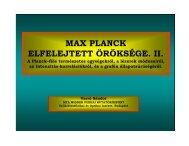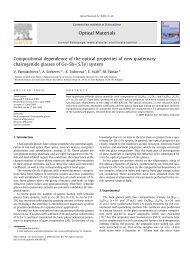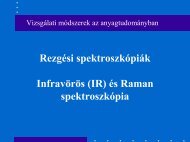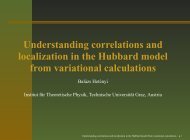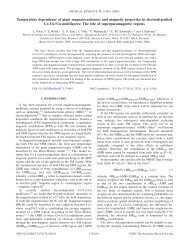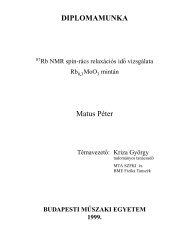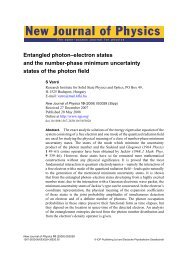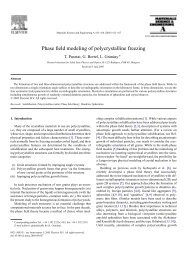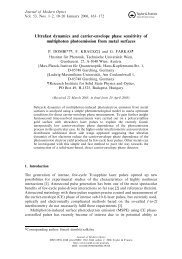ANNUAL REPORT - MTA SzFKI
ANNUAL REPORT - MTA SzFKI
ANNUAL REPORT - MTA SzFKI
Create successful ePaper yourself
Turn your PDF publications into a flip-book with our unique Google optimized e-Paper software.
entanglement one has to find methods that need few measurements. Moreover, in manyparticle<br />
systems typically the particles cannot be addressed individually. Thus these<br />
methods can only use collective measurements. We have been working on methods for<br />
entanglement detection under these circumstances. On the one hand, we participated in an<br />
experiment carried out at the Max Planck Institute for Quantum Optics, where a four-qubit<br />
quantum state was created with photons, and the methods developed were used for<br />
entanglement detection. On the other hand, we determined the complete set of generalized<br />
spin squeezing inequalities that can detect entanglement in many-particle experiments.<br />
Finally, we worked on other aspects of entanglement detection issues related to mixed<br />
state quantum computing, and local hidden variable models.<br />
We generalized the concept of recurrence probability (Pólya number) for d-dimensional<br />
unbiased quantum walks. A sufficient condition for a quantum walk to be recurrent was<br />
derived. As a by-product we have found a simple criterion for localisation of quantum<br />
walks. In contrast to classical walks, where the Pólya number is characteristic for the given<br />
dimension, the recurrence probability of a quantum walk depends in general on the<br />
topology of the walk, choice of the coin and the initial state. This allows to change the<br />
character of the quantum walk from recurrent to transient by altering the initial state.<br />
Nuclear motion in molecules. — dynamics and spectroscopy. – A technique has been<br />
developed which in principle allows the determination of the full rotational-vibrational<br />
eigenspectrum of triatomic molecules by treating the important singularities present in the<br />
triatomic rotational-vibrational kinetic energy operator given in Jacobi coordinates and the<br />
R, embedding. A generalized finite basis representation resulting in a nonsymmetric<br />
Hamiltonian matrix has been employed. The basis set to be used is obtained by taking the<br />
direct product of a 1-D DVR basis, related to R1, with a 5-D nondirect-product basis, the<br />
latter formed by coupling Bessel-DVR functions depending on the distance-type<br />
coordinate causing the singularity, associated Legendre polynomials depending on the<br />
Jacobi angle, and rotational functions depending on the three Euler angles. The robust<br />
implicitly restarted Arnoldi method within the ARPACK package is used for the<br />
determination of a number of eigenvalues of the nonsymmetric Hamiltonian matrix. The<br />
suitability of the proposed approach is shown by the determination of the rotationalvibrational<br />
energy levels of the ground electronic state of H-3(+) somewhat above its<br />
barrier to linearity. Convergence of the eigenenergies is checked by an alternative<br />
approach, employing a Hamiltonian expressed in Radau coordinates, a standard directproduct<br />
basis, and no treatment of the singularities.<br />
E-Mail:<br />
Péter Ádám<br />
János Asbóth<br />
Péter Domokos<br />
Aurél Gábris<br />
József Janszky<br />
Orsolya Kálmán<br />
Attila Kárpáti<br />
Zsolt Kis<br />
Tamás Kiss<br />
Mátyás Koniorczyk<br />
Zoltán Kurucz<br />
Dávid Nagy<br />
adam@szfki.hu<br />
asboth@optics.szfki.kfki.hu<br />
domokos@szfki.hu<br />
gabrisa@optics.szfki.kfki.hu<br />
janszky@szfki.hu<br />
kalman@szfki.hu,<br />
karpati@optics.szfki.kfki.hu<br />
zsolt@szfki.hu<br />
tkiss@optics.szfki.kfki.hu<br />
kmatyas@optics.szfki.kfki.hu<br />
kurucz@szfki.kfki.hu<br />
nagyd@optics.szfki.kfki.hu,<br />
86



